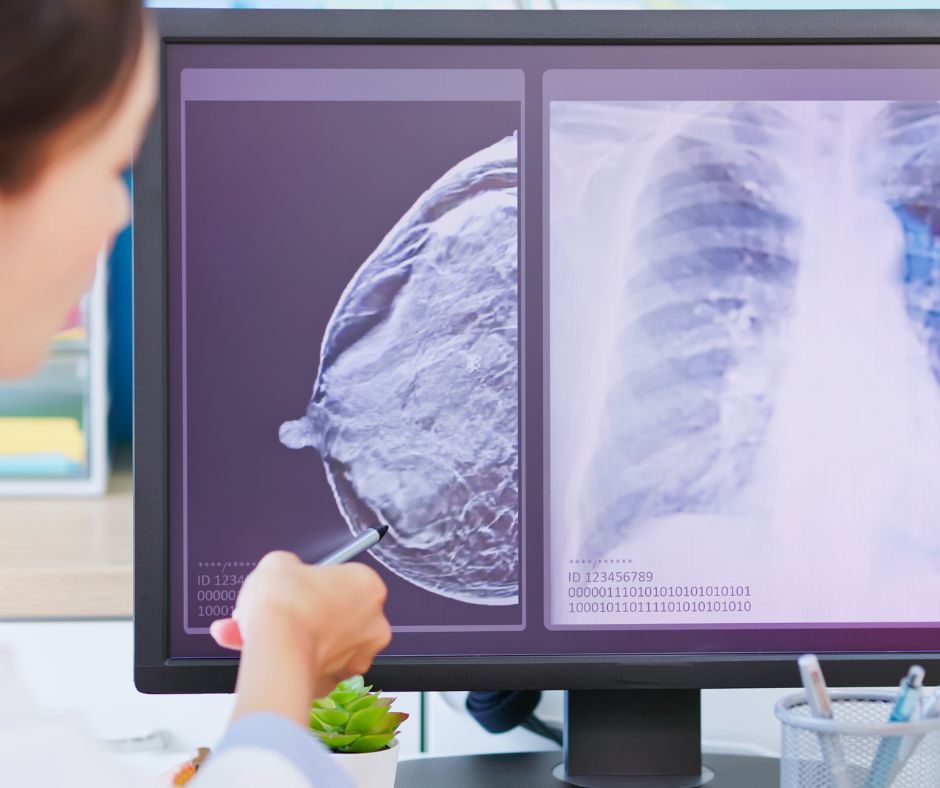Breast cancer is a condition where abnormal cells in the breast grow uncontrollably and tumours develop. Most breast cancers are sporadic and develop by chance, and some are inherited due to genetic mutations. Understanding the difference between these types of breast cancer is vital when discussing risk factors, prevention strategies, and breast cancer treatment.
Types of Breast Cancer
Sporadic breast cancer accounts for the majority of cases. It arises from gene damage that occurs randomly after birth. It is not hereditary, and its underlying causes involve a combination of hormonal exposures, lifestyle factors, environmental influences, and normal physiological processes.
Inherited breast cancer is less common and results from mutations passed down within families, particularly in genes like BRCA1, BRCA2, and PALB2. They usually suppress cell growth and prevent cancer development, but when mutated, they can cause uncontrolled cell growth and increase the risk of breast cancer.
Age and Personal History
Age is a significant risk factor for breast cancer, with most cases diagnosed after the age of 50. Women who have previously had breast cancer in one breast face a higher cancer risk in the other breast.
Family History and Genetic Predisposition
The risk is higher if:
- one or more women in the family were diagnosed with breast cancer before age 50
- if multiple generations on one side of the family have a history of breast or ovarian cancer
- if male breast cancer is present in the family
- those with Ashkenazi Jewish ancestry
- Mutations in genes like BRCA1 and BRCA2 are linked to an elevated risk of breast and ovarian cancers. Genetic testing helps identify individuals with these mutations, serving as a risk-reducing strategy and early detection measure.
Personal History of Ovarian Cancer
People with a history of ovarian cancer caused by a BRCA gene mutation are also at a high risk of breast cancer. Genetic counselling and risk assessment should be implemented to conduct only appropriate screening and prevention strategies.
Menstruation, Menopause, and Timing of Pregnancy
Early menstruation (before ages 11 or 12) and late menopause (after age 55) expose breast cells to oestrogen and progesterone for an extended period. This increases the risk. On the other hand, early pregnancies and multiple full-term pregnancies may reduce the risk of breast cancer.
Hormone Replacement Therapy and Oral Contraceptives
Having hormone replacement therapy with both oestrogen and progestin after menopause elevates breast cancer risk. Some studies suggest that oral contraceptives may slightly increase the risk of breast cancer, while others show no significant link. Patients should discuss the potential risks and benefits of hormone therapies with their doctors.
Race, Ethnicity, and Breast Density
White women have a higher likelihood of developing breast cancer, while Black women are more commonly diagnosed with the disease before age 45. Breast density or the amount of tissue in the breast relative to fat also influences breast cancer risk; dense breast tissue increases the risk and may complicate tumour detection through standard imaging tests.
Lifestyle Factors
- Certain lifestyle choices contribute to breast cancer risk.
- being overweight or obese
- having low physical activity levels
- consuming more than 1 to 2 servings of alcohol daily
- Adopting healthy lifestyle habits can help reduce your risk.
Socioeconomic Factors and Radiation Exposure
More affluent women have higher risks than less affluent women. Exposure to ionising radiation at a young age also increases risk.
Address these disparities by undergoing proper screening and regular checkups.
Assessing Breast Cancer Risk
Several risk assessment tools, like the Gail model, have been developed to estimate a person’s chance of developing breast cancer.
Genetic counselling may provide more accurate risk assessments for those with a strong family history or a personal history of breast cancer.
Prevention Strategies
- If you think you are at a high risk of developing breast cancer, take proactive measures to reduce these chances.
- regular physical activity
- maintaining a healthy weight
- avoiding hormone replacement therapy
- breastfeeding
- All of these help lower the risk.
Prophylactic mastectomy and salpingo-oophorectomy may be considered for those with a genetic predisposition.
Conclusion
In addition to understanding the risk factors, regular screenings and open conversations with a breast specialist in Singapore are significant in detecting breast cancer early and improving treatment outcomes. Fostering a proactive approach towards breast health to make significant strides in reducing the burden of breast cancer on people and communities.
References
https://www.cancer.net/cancer-types/breast-cancer/risk-factors-and-prevention
https://www.cdc.gov/cancer/breast/basic_info/risk_factors.htm








